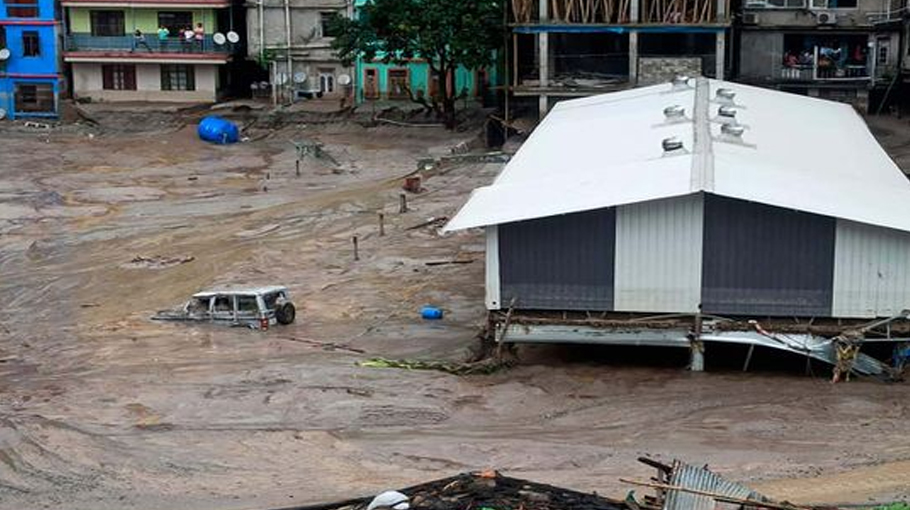There is a looming crisis ignited by climate change
Cross-border cooperation essential to address risks posed by glacial lake outburst floods

The last week’s tragedy in Sikkim, India, where a glacial lake outburst flood (GLOF) led to collapse of a hydropower dam and claimed over twenty lives and left over a hundred people missing including a number of army men, serves as a grim reminder of the growing threat of GLOFs in the Himalayas.
This incident, triggered by continuous heavy rainfall, underscores the dire consequences of climate change-induced glacier melting and the expansion of glacial lakes in the region.
GLOFs are not a new phenomenon, but they have become increasingly common and devastating due to the changing climate. Glacial lakes, like the South Lhonak Lake in Sikkim, form as glaciers melt, and they often become dammed by unstable ice or sediment.
When these dams rupture, they release massive volumes of water downstream, leading to flash floods that can wreak havoc on communities and infrastructure. These disasters have taken place in other Indian states like Himachal Pradesh, Uttarakhand, and Arunachal Pradesh in recent years.
Exposure to GLOF risks
The Himalayas, with its rapidly melting glaciers, are a hotspot for GLOFs. South Lhonak Lake, in particular, has been expanding over the past few decades due to glacier retreat, making it a ticking time bomb.
Scientists had warned about the potential for a GLOF event at this lake as early as 2013, and reports from 2001 highlighted the looming threat of GLOFs in the region. Yet, the disaster that happened last week raises questions about the effectiveness of preventive measures and early warning systems.
The tragic incident in Sikkim is just one example of a broader crisis. A recent study reveals that 15 million people worldwide are exposed to GLOF risks. What’s more alarming is that more than half of this threatened population resides in just four nations: China, India, Pakistan, and Peru.
The study conducted a comprehensive assessment by surveying populations in 1,089 basins containing glacial lakes identified through satellite imagery, encompassing a total of 90 million people across 30 countries. The Himalayas faces the highest exposure to the GLOF risks.
This risk analysis didn’t just take geographical proximity into account; it also factored in socioeconomic data to evaluate communities’ vulnerability and their capacity to cope with such a disaster.
OPN SIKKIM FLOOD 2
Rapid retreat of glaciers
It is important of considering both physical factors, such as the conditions of glacial lakes, and societal factors, including exposure and vulnerability, when assessing GLOF risks. Switzerland and Nepal, both facing increasing threats from glacier-related hazards but differing significantly in their capacities to react.
Climate change is driving glacier melt and the growth of glacial lakes, making GLOFs an escalating threat. While the frequency of GLOFs may not have increased directly due to climate change, the larger glacial lakes formed by melting glaciers are more hazardous when flooding occurs.
The research reveals that over the past 30 years, the volume of glacier lakes globally has increased by 50 per cent due to the melting of glaciers caused by global warming. While Earth’s average surface temperature has risen by nearly 1.2 degrees Celsius since preindustrial times, high-mountain regions have warmed at twice that rate.
On Earth’s Third Pole, the Himalayas, which is a high-altitude region with lots of ice, the warming climate is causing the ice to melt quickly. This is leading to the creation and growth of glacial lakes, which have become very dangerous for people living downstream.
In analysing the history, current status, and future changes in these glacial lakes, research finds that the highest GLOF risk is in the eastern part of Himalayas, where the risk is at least twice as high as other high-altitude areas. In the future, this risk could nearly triple due to more lake development, and new risk areas will appear to the west.
There is serious concern over increasing number of devastating GLOFS in the Himalayas due to the rapid retreat of glaciers caused by global warming. India and Pakistan have been facing a number of GLOF disasters in recent years.
Their northern areas have witnessed multiple GLOFs, with rising temperatures exacerbating the problem. These floods have caused significant damage to infrastructure, homes, agriculture, and people’s lives. Glacial lake outburst floods compound the water scarcity issues India and Pakistan face.
Severe damage to infrastructure
China’s Tibet Autonomous region is identified as a high-incidence area for GLOFs, experiencing numerous incidents since 1960. These floods have resulted in severe damage to infrastructure and loss of lives in downstream areas, highlighting the urgent need for preventive measures.
Bhutan, despite being carbon-negative, faces the impact of climate change, with glaciers melting rapidly and raising the water levels in glacial lakes. The risk of GLOFs, especially in areas like Lunana, threatens not only communities but also vital hydropower dams.
The increasing number of GLOFs in the Himalayan region not only leads to repeated humanitarian disasters but also adds further complexity to water resource management in these countries. These events introduce sudden, unpredictable occurrences with far-reaching and devastating consequences for communities, infrastructure, and ecosystems.
To reduce the risks, countries in the region need to develop early warning systems, infrastructure resilience measures, and cooperative disaster preparedness.
Since many glaciers and glacial lakes in the Himalayas span multiple countries, cooperation and agreements between nations are necessary to address the shared risks and responsibilities associated with GLOFs.
To address the rapidly-emerging GLOF crisis, the Himalayan countries also must prioritise climate action at the region level and invest in climate-resilient infrastructure.
At the same time, they should take the lead role in pressuring major carbon-emitting countries to accelerate emissions reduction and transition to renewable energy sources.
Ashok Swain is a professor of peace and conflict research at Uppsala University, Sweden
Source: Gulf News


